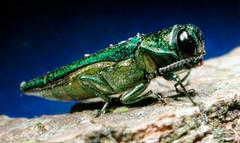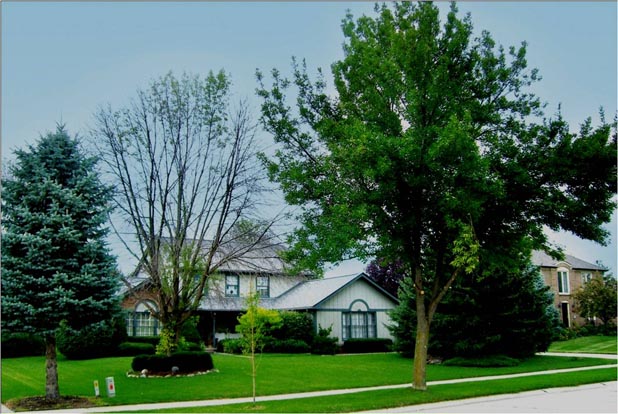
Emerald Ash Borer is a small metallic green beetle that feeds on the inner bark of all species of ash trees. The insect is an invasive species native to Northeast Asia and was introduced to the United States in the early 2000's. The insect has rapidly spread throughout the Lake States and is now found in 22 states. The adult insect emerges from the inner bark of ash trees any time between May and September, leaving D-shaped holes as it exists. Female beetles lay eggs underneath crevices in the bark, and as these eggs hatch, the larvae feed on the wood tissue just beneath the bark. The feeding inhibits the tree's ability to transport nutrients and water, killing the tree. Unlike other types of borers (insects that typically only feed on damaged, low vigor or dying plants), EAB attacks healthy trees as well as weakened ones. Left untreated, EAB will cause the tree to die.
How do I know if my tree is infected with EAB?
Emerald Ash Borer only attacks ash trees. Ash trees (Fraxinus spp.) are abundant in Wisconsin - there are an estimated 834 million ash trees in the state, making up 7% of the state's woodland trees and up to 25% of urban trees. It is easy to identify an ash tree when looking for these characteristics:
- Compound leaves composed of 5-11 leaflets
- Paddle-shaped seeds on female trees
- Opposite branching (branches in pairs directly across from each
- other)
- Diamond-shaped ridges in bark
To identify whether or not your ash tree has EAB, you'll need to look for these symptoms:
- Branch dieback
- Canopy thinning
- Excessive sprouting
- Woodpecker activity
- D-shaped holes in the bark (approximately 1/8 in. wide)
- Winding tunnels under the bark
What should I do to protect my ash tree?
Evaluate the worth of your ash tree or trees. Is your tree healthy, structurally sound and a good landscape specimen? Does the tree add value to your home or property? Does the tree have special meaning to you? Will you miss it when it's gone? If so, you should save it. Treatment, especially for larger trees, is the less expensive and more environmentally sound approach to EAB management.

However, not every ash tree is a good candidate for treatment. Consideration should be made to remove small, decayed or storm-damaged trees, or those that have other serious problems. First Choice would be happy to evaluate your situation and have our arborists give their best professional opinions on any or all of your trees.
Research has shown nearly 100% survival of ash trees when treated with Emmamectin benzoate (TREEage). Protection prior to EAB discovery is most effective; the earlier the treatment, the better chance you have of saving your trees. First Choice's TREEage treatment plan is an industry-leading protective and curative plan, and we guarantee that it will work. Call us today to learn more about your treatment options.

